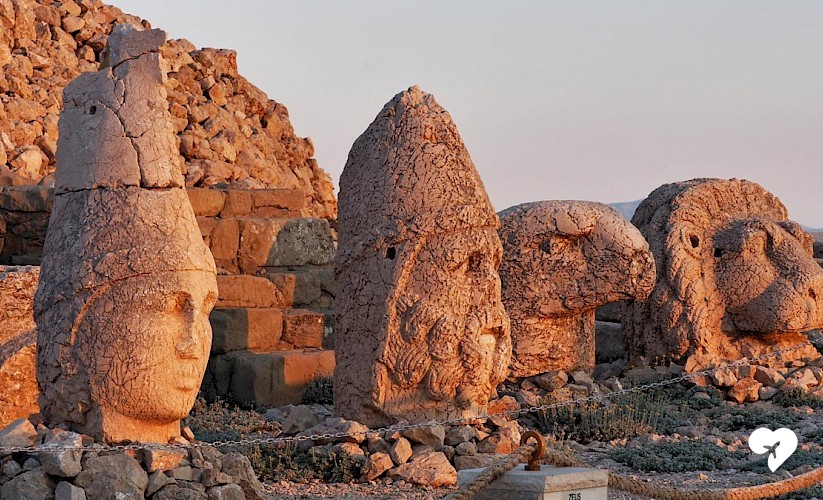The Mount Nemrut is one the highest peaks of the Mesopotamia, and its summit at 2,206 metres above the sea level contains the tomb of King Antiochus I of Commagene, commissioned by himself. The gigantic statues of gods, each weighing 6 tons and 10 metres tall, indicate what kind of super-human effort was spent on the construction of the tomb. Boulders were the main material used and they were carried up the mountain from the valley below, and similarly the crushed rock pieces used to pile over the main tomb chamber in order to create a 50 ‑metre high cone with 150-metre diameter base were carried the same way. This creative scheme has proven to be effective and prevented grave robbers accessing to the inner sanctum. The tomb chamber is yet to be accessed and the treasures inside are awaiting discovery. However the statues of gods and the sanctuary formed along the three aspects of the tumulus are considered unique, and consequently it was inscribed in the UNESCO List of World Heritage.
Junction of Eastern and Western Civilisations: Heritage of Commagene Kingdom
The Commagene Kingdom dominated the region for almost two centuries between 109 BC and 72 AD, and it appears to be a remarkable civilisation unifying the cultures and beliefs of Macedonian and Persian civilisations. It is also indicative that Mithridates I Callinicus, the founder of the kingdom had ancestral lineage deriving from both Darius the Great of Achaemenid Empire and Alexander the Great of the Kingdom of Macedon, and that relationship had a bearing on this unifying process.
For a while Commagene Kingdom was the most powerful state of the region, and other structures of its spectacular heritage could be seen in the Adıyaman province. The burial place of female members of Commagene royal family, which is known as the Giant Eagle Royal (Karakus) Tumulus, is adorned with four tall pedestals – today only one of them stand erect with an eagle sculpture on top; the Necropolis of Perre, which was situated in one of the largest settlements (near Pirin Village) where the floor mosaics were unearthed; Arsameia (Eskikale), one of the temene of the Kingdom where once the palaces were standing, are the other sites to visit for those who wish to learn about that civilisation more closely.

Those who are interested in history of cultures would also find artefacts and structures from other civilisations that survived on this land which cradled various civilisations for thousands of years. One of the oldest Roman bridges in Anatolia is the Severan Bridge (Cendere Köprüsü) from the 1st century AD, which was built by the Commagene Kingdom. The other is the New Castle in Old Kahta, which was believed to be founded in 2nd century BC but extensively rebuilt during the Mamluk Sultane domination of the region.
A Magnificent Sunrise
One of the essential rituals of visiting Mount Nemrut is enjoying the sunrise from the summit. King Antiochus, revering his ancestors in Western and Eastern civilisations, erected giant statues of gods on the East and West terraces and cited their names both in Persian and Greek. So visitors enjoy watching the unique sunrise together with the statues of gods who have been witnessing it for two thousand years.
How to Go?
The Mount Nemrut Tumulus is in Kahta county which is 86 km east of Adıyaman city. There are scheduled flights to Adiyaman Airport from Istanbul and Ankara. The best season for ascent to the Mount is the period between April and October.
